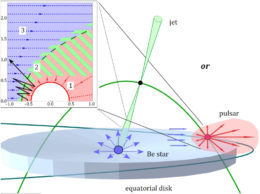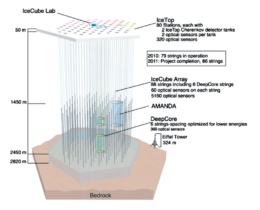Particles are accelerated all over the universe, but exactly how they get so energetic often remains a mystery. A team of scientists has come up with a model involving stellar winds to explain some intense bursts from binary systems.
LHAASOing High-Energy Particles
High-energy blasts of radiation can come from all different types of sources, from streams of charged particles from supermassive black holes to high-energy rays produced by our own Sun. Some sources of especially high-energy photons — energetic gamma rays — also produce accompanying bursts of neutrinos.
Gamma-ray observatories such as the Large High Altitude Air Shower Observatory (LHAASO) and the Carpet-2 experiment have captured phenomenally energetic photons from more than a dozen sources in the past ten years. Some of these detections have been accompanied by neutrino outflows, which have been observed by the IceCube detector, an observatory at the South Pole containing thousands of sensors distributed throughout a cubic kilometer of Antarctic ice. These detections point to astronomical sources able to accelerate particles to mind-boggling petaelectronvolt (PeV) energies. One PeV is one quadrillion electronvolts — one thousand times the kinetic energy of a flying mosquito, packed into a single particle. A group led by Andrei Bykov from the Ioffe Physical-Technical Institute in Russia may have now come up with a model to explain what powers these ultra-energetic accelerators.
A Compact Explanation

A diagram of the model. The pulsar wind is in pink, the cross-hatched green is the zone of contact discontinuity, the blue is the stellar wind. [Bykov et al. 2021]
This scheme explains how these events get so energetic, and it can even explain lower-energy gamma-ray events that coincide with high-energy neutrinos. These neutrinos, which may greatly contribute to the high-energy neutrino flux in the galaxy, should be detectable by IceCube, so future observations may provide a test of this model.
Citation
“PeV Photon and Neutrino Flares from Galactic Gamma-Ray Binaries,” A. M. Bykov et al 2021 ApJL 921 L10. doi:10.3847/2041-8213/ac2f3d


